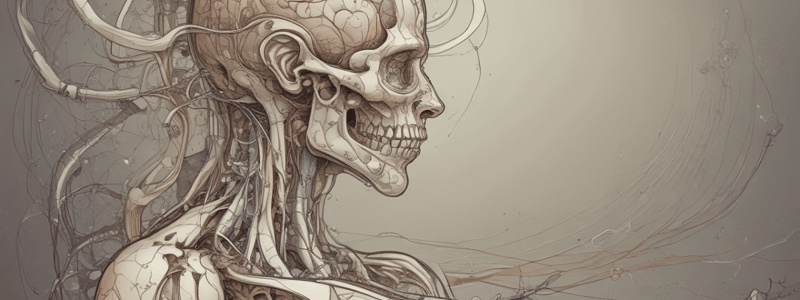Podcast
Questions and Answers
What is the pathway of the visual information from the retina to the visual cortex?
What is the pathway of the visual information from the retina to the visual cortex?
- Retina → Lateral geniculate nucleus → Optic nerve → Optic chiasm → Visual Cortex
- Retina → Optic tract → Lateral geniculate nucleus → Optic nerve → Visual Cortex
- Retina → Optic chiasm → Optic nerve → Lateral geniculate nucleus → Optic tract → Visual Cortex
- Retina → Optic nerve → Optic chiasm → Optic tract → Lateral geniculate nucleus → Visual Cortex (correct)
What is the result of a lesion in the optic nerve?
What is the result of a lesion in the optic nerve?
- Monocular visual loss with ability to compensate from contralateral side (correct)
- No visual symptoms
- Blurred vision and loss of color vision
- Loss of visual information that can be compensated from the contralateral side
What is the function of the ganglion cells in the retina?
What is the function of the ganglion cells in the retina?
- To convert light into electrical signals
- To transmit visual information from the retina to the brain (correct)
- To produce glutamate
- To regulate the amount of light that enters the eye
What is the result of a Cecocentral scotoma?
What is the result of a Cecocentral scotoma?
What is the structure that receives direct ganglion cell fibers from the retina?
What is the structure that receives direct ganglion cell fibers from the retina?
What is the function of the aqueous humour in the eye?
What is the function of the aqueous humour in the eye?
What is the structure that carries visual information from the eye to the brain?
What is the structure that carries visual information from the eye to the brain?
Lesions in which part of the visual pathway can cause visual field deficits?
Lesions in which part of the visual pathway can cause visual field deficits?
What is the function of the ganglion cells in the retina?
What is the function of the ganglion cells in the retina?
What is the blood vessel that supplies the retina?
What is the blood vessel that supplies the retina?
What is the approximate rate of visual information leaving each eye?
What is the approximate rate of visual information leaving each eye?
Which type of RGCs are more sensitive to motion and have larger receptive fields?
Which type of RGCs are more sensitive to motion and have larger receptive fields?
What is the term for the atrophy of RGCs in the optic nerve due to lesions to the 2° neuron axons within the brain?
What is the term for the atrophy of RGCs in the optic nerve due to lesions to the 2° neuron axons within the brain?
What is the approximate diameter of the fovea centralis?
What is the approximate diameter of the fovea centralis?
Which part of the retina lacks blood vessels and contains densely packed cones?
Which part of the retina lacks blood vessels and contains densely packed cones?
What is the result of an ischemic lesion of the proximal optic nerve?
What is the result of an ischemic lesion of the proximal optic nerve?
Which retinal fibers do not cross in the optic chiasm?
Which retinal fibers do not cross in the optic chiasm?
What is the most common cause of a junctional scotoma?
What is the most common cause of a junctional scotoma?
What is the target of the optic tracts in the subcortical visual structures?
What is the target of the optic tracts in the subcortical visual structures?
Which pathway is involved in the reorientation to visual and auditory stimuli?
Which pathway is involved in the reorientation to visual and auditory stimuli?
What is the characteristic appearance of the optic disc due to axonal degeneration?
What is the characteristic appearance of the optic disc due to axonal degeneration?
Which part of the visual field is associated with the temporal retina?
Which part of the visual field is associated with the temporal retina?
Where do ganglion cells from the nasal hemiretina project to?
Where do ganglion cells from the nasal hemiretina project to?
What is the characteristic visual field defect associated with lesions of the nasal hemiretina?
What is the characteristic visual field defect associated with lesions of the nasal hemiretina?
Which visual field is wider superiorly than inferiorly?
Which visual field is wider superiorly than inferiorly?
During early development, which two structures interact to form the adult retina and lens?
During early development, which two structures interact to form the adult retina and lens?
What is the function of horizontal cells in the retina?
What is the function of horizontal cells in the retina?
What is the direction of light and visual information travel in the vertebrate retina?
What is the direction of light and visual information travel in the vertebrate retina?
What is the function of Müller cells in the retina?
What is the function of Müller cells in the retina?
In which region of the retina are the layers thinnest?
In which region of the retina are the layers thinnest?
What percentage of total ganglion cells are uncrossed fibers from the temporal hemiretina?
What percentage of total ganglion cells are uncrossed fibers from the temporal hemiretina?
Which part of the visual field is affected in Bitemporal Hemianopsia?
Which part of the visual field is affected in Bitemporal Hemianopsia?
What is the location of fibers from the superior visual field in the optic chiasm?
What is the location of fibers from the superior visual field in the optic chiasm?
What is the term for the loop of contralateral fibers in the optic nerve?
What is the term for the loop of contralateral fibers in the optic nerve?
What is the characteristic visual field defect of a lateral compression of the optic chiasm?
What is the characteristic visual field defect of a lateral compression of the optic chiasm?
From which part of the retina do uncrossed fibers originate?
From which part of the retina do uncrossed fibers originate?
What is the term for the bilateral 'bowtie' atrophy of the optic disk?
What is the term for the bilateral 'bowtie' atrophy of the optic disk?
What is the location of the lesion in a patient with Bitemporal Hemianopia caused by a pituitary adenoma?
What is the location of the lesion in a patient with Bitemporal Hemianopia caused by a pituitary adenoma?
What is the characteristic of ganglion cell fibers in humans and other primates?
What is the characteristic of ganglion cell fibers in humans and other primates?
What is the term for the progression of vision loss that can be used to locate the lesion?
What is the term for the progression of vision loss that can be used to locate the lesion?
Flashcards are hidden until you start studying
Study Notes
Visual Field and Retinal Fields
- The visual field is larger superiorly than inferiorly, and the temporal visual field is larger than the nasal visual field.
- The binocular visual field is wider superiorly than inferiorly.
- Temporal hemiretinas: 40% of ganglion cell fibers, receive images from medial visual field, and project to ipsilateral LGN (layers 2, 3, 5).
- Nasal hemiretinas: 60% of ganglion cell fibers, receive images from lateral visual field, and project to contralateral LGN (layers 1, 4, 6).
Main Visual Pathway (Retino-Geniculo-Calcarine)
- Retina: photoreceptors (rods and cones) -> bipolar cells -> 1° ganglion cells -> 2° optic nerve.
- 2° optic nerve -> 2° optic chiasm -> 2° optic tract -> 2° lateral geniculate nucleus -> 3° optic radiation -> 3° visual cortex (occipital lobe).
Visual Pathway Lesions
- Lesions in the retina or optic nerve can cause monocular visual loss, without the ability to compensate from the contralateral side.
- Lesions before the optic chiasm can cause blurred vision and loss of color vision (achromatopsia), while lesions after the chiasm will not.
- Local lesions in the retina can cause scotoma, which is a blind spot in the visual field.
- Cecocentral scotomas are lesions of the retina that fuse with the blind spot.
- Central scotomas and claudication are often symptoms of optic nerve ischemia.
Optic Chiasm
- The optic chiasm is the part of the brain where the optic nerves from each eye cross over to the opposite side.
- Ganglion cell axons from each nasal hemiretina cross at the chiasm.
- The suprachiasmatic nucleus of the hypothalamus receives direct ganglion cell fibers.
Retinal Anatomy
- The retina has 10 histologic layers, including photoreceptors (rods and cones), bipolar cells, and ganglion cells.
- The neural layer of the retina contains ganglion cells, bipolar cells, and interneurons.
- The pigmented layer of the retina is involved in the metabolism of the internal eye structure.
Optic Nerve
- The optic nerve is formed from the axons of ganglion cells.
- The optic nerve has a papillomacular bundle, which is a bundle of axons from the nasal retina.
- Lesions to the 2° neuron (RGC) axons within the brain can cause retrograde "Wallerian" atrophy of RGCs in the optic nerve.
Visual Field Defects
- Bitemporal hemianopia: a visual field defect characterized by bilateral blindness in the temporal fields.
- Binasal hemianopia: a visual field defect characterized by bilateral blindness in the nasal fields.
- Junctional scotoma: a central scotoma of the ipsilateral eye, and a superior temporal crescent loss in the contralateral eye.
Other
- The retina and optic nerve are outgrowths of the diencephalon, not technically part of the PNS.
- The lens placode and optic vesicle interact during early development to form the adult retina and lens.
Studying That Suits You
Use AI to generate personalized quizzes and flashcards to suit your learning preferences.




